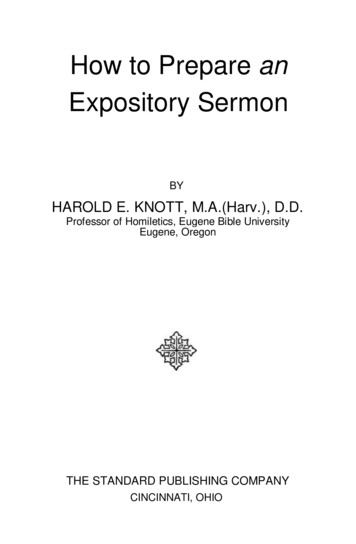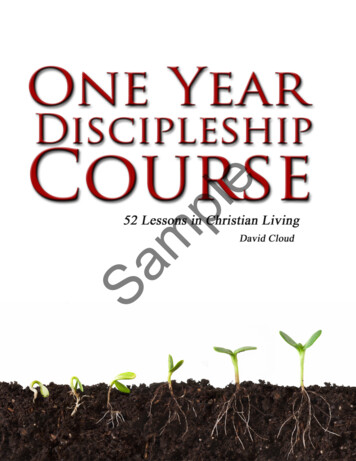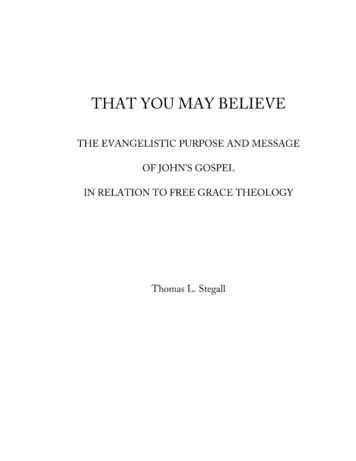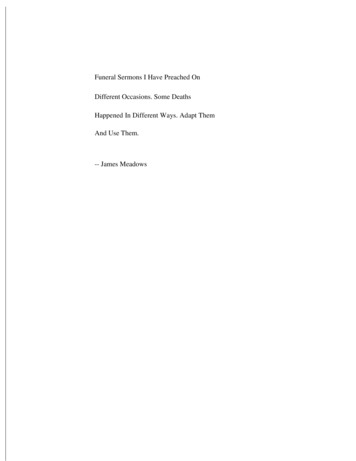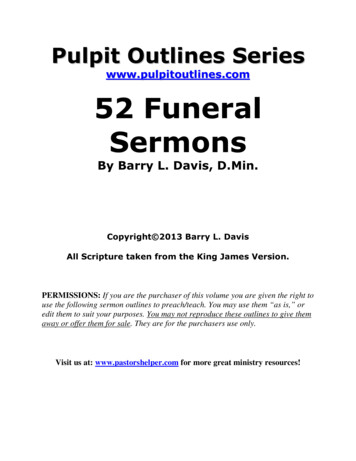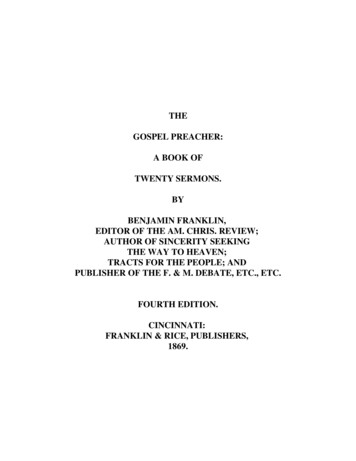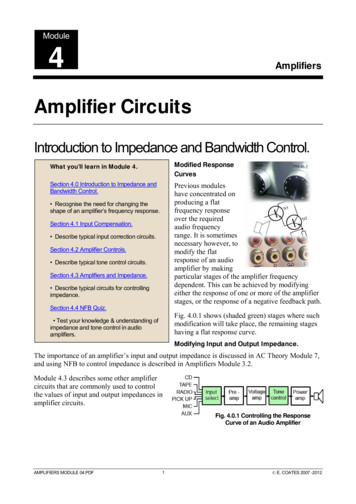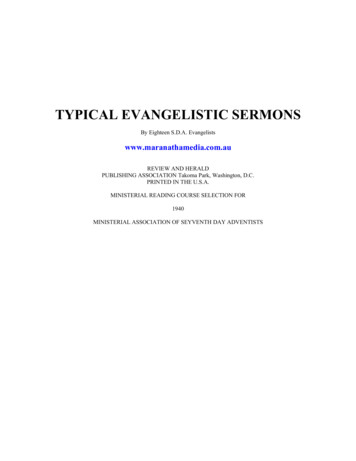
Transcription
TYPICAL EVANGELISTIC SERMONSBy Eighteen S.D.A. Evangelistswww.maranathamedia.com.auREVIEW AND HERALDPUBLISHING ASSOCIATION Takoma Park, Washington, D.C.PRINTED IN THE U.S.A.MINISTERIAL READING COURSE SELECTION FOR1940MINISTERIAL ASSOCIATION OF SEYVENTH DAY ADVENTISTS
TYPICAL EVANGELISTIC SERMONSCONTENTSForewordIntroduction by W. G. Turner1. The Dream of World Empire(Daniel 2)By Taylor G. Bunch2. Christ the Coming King(Second Advent)By Elmer L. Cardey3. The Bible Millennium(Millennium)By Carlyle B. Haynes4. The One Priceless Book(Inspiration of Bible)By Frederick Lee5. The Truth About Heaven(Heaven)By Robert S. Fries6. Why Was Sin Permitted?(Origin of Evil)By John W. MacNeil7. Can Man Bridge the River of Death?(The Gospel of Salvation) By John L. Shuler8. Are the Ten Commandments Out of Date? (Perpetuity of Law)By Jesse C. Stevens9. Which Is “the Lord’s Day”?(The Lord’s Day)By Harold M. S. Richards10. Jesus Amid the Shadows(Law and Gospel)By R. Allan Anderson11. Has Grace Superseded the Law?(Law and Grace)By Charles T. Everson12. Jesus the Hope of the World(Christ Our Only Savior) By J. L. Tucker13. Where Are the Dead?(State of Dead)By Robert L. Boothby14. What and Where Is Hell?(Hell)By Clifford A. Reeves15. Jehovah’s Sanctuary and Its Service(The Sanctuary)By O. O. Bernstein16. What Was Abolished at the Cross?(The Two Laws)By James Earl Shultz17. Twice Born or Die Twice(Conversion)By Chester S. Prout18. The Gateway to a New Life(Baptism)By Leonard C. Evans2www.maranathamedia.com.au
TYPICAL EVANGELISTIC SERMONSFOREWORDAT a meeting of the Ministerial Association Advisory Council, in December, 1939, a volume ofevangelistic sermons was proposed, each presentation to be prepared by a different evangelist. Such a planwas formulated because it was thought best not to have any one evangelist write an entire series, or to setforth any one individual as a denominational model. It was believed that by enlisting the services of a scoreof able, experienced, successful men for one message sermon each, a product could be secured that wouldprove to be a distinct stimulus to younger workers, as well as of keen interest to all ministers to see howothers treat an evangelistic theme of importance. The proposed plan was well received by the AdvisoryCouncil. A committee of five was then named to formulate a plan of procedure. This committee requestedeach of the evangelists selected to choose topics from an accompanying list, upon which he preferred towrite. To each of these evangelists, the following guiding paragraph was sent:“We desire to have exemplified an effective approach and development of a great theme, togetherwith a real heart appeal-in short, to capitalize the possibilities of one of God’s great truths for the hour tothose not of our faith. Three principles should prevail: (1) Making Christ the central theme of everydiscourse, (2) making the threefold commission of Revelation 14 the binding principle in the series, and (3)making every sermon tell in preparing the soul for the coming of the Lord. Undoubtedly some chart,diagram, or device would be used in connection with certain of the presentations. Miniatures of theseshould doubtless accompany the manuscript, so as to make clear the various factors that enter into asuccessful evangelistic sermon. Great care’ should, of course, be exercised to state all historical or otherfacts exactly, and to quote citations accurately.”A committee of judges was next named to make the final selections. This volume constitutes theresult. These messages are not sent forth as super sermons, polished to a high degree of literary perfection,but rather as typical sermons actual presentations-drawn from successful and experienced evangelists. Theyare not presented as models for copying, but rather for comparison. Another feature of value is that onemay see what sort of preaching outline others use in presenting a given theme, and likewise the kind ofhandbill or chart employed. Becoming dignity, and Biblical and spiritual emphasis, blended with winsomeappeal, constitute the ideal for which we must and do strive. The book is now sent forth with a prayer that itmay prove a real blessing and distinct stimulus to our workers generally.It is hoped that if this sermon volume is well received, a second will follow later with yet otherwriters and other topics, especially stressing our testing truths and demonstrating the most effective appealthe latter constituting one of the most vital, yet often one of the weakest, features in public evangelism.MINISTERIAL ASSOCIATION OFTHE GENERAL CONFERENCE OF SEVENTH-DAY ADVENTISTSWashington, D.C. August 1, 1940.INTRODUCTIONTHE hour is late, and the end of all things earthly is near and hastens greatly. The longcontroversy between the forces of good and evil is almost ready for its terrifying and eternal climax.Immediately preceding this fateful hour, the message of God is to be proclaimed in clarion tones, and theHoly Spirit is to work in human life with unrestricted power. Called of God, each evangelist is now to standin his place facing the demands of a confused world with fruitfulness in his service and with the knowledgeof assured triumph for his cause. He is to accept the challenge of lost men who can be saved only throughacceptance of the gospel of Christ, which “is the power of God unto salvation to everyone that believes.”In its proclamation, this message of salvation is to be so convincing that skeptics will beconfounded, so constructive that even firmly entrenched theory will vanish before immovable truth, sosimple that the ignorant will clearly understand, so mighty that opposing forces will surrender, so chargedwith divine power that human philosophy will be swept aside, and so impregnated with the word of theliving God that all who read or hear will recognize God’s voice.It is tragic to note the poverty of united thought and the almost total absence of authoritative3www.maranathamedia.com.au
TYPICAL EVANGELISTIC SERMONSpreaching in the ministry of modern Christendom. Because of this confusion and uncertainty, men havelargely lost their love for God’s word and their respect for God’s professed ministry. While many earnestsouls long for light and truth, they appear compelled to grope and stumble in the dark, frantically graspingat anything within reach in the hope that what they secure will Ultimately lead them to their desired haven.How refreshing to find in such times as these that the ministry of the Seventh-day AdventistChurch has never lost its consciousness of the value of certain fundamental doctrines and prophecies whichare frequently and rightly called pillars of the faith. These are sound, safe, and spiritual.These doctrinal pillars occupy so prominent and important a place in our evangelistic preachingthat they enable our ministers with one voice, yet withal in many tongues, to proclaim them the worldaround, with results that produce one great family of believers, who individually and collectively form whatconstitute God’s remnant church. These members are instructed doctrinally and equipped spiritually tomeet Christ when He “shall appear the second time without sin unto salvation.”Because our ministry speaks with this one voice, this volume has been prepared and is submittedas a Ministerial Reading Course book for our evangelists and evangelistic workers the world around. Itcontains sermons preached by almost a score of evangelists, drawn from so wide a field as Asia, Africa,North America, Europe, and Australia. It should serve as a most helpful stimulus from the angle of methodemployed as well as of the value of its content.Recognizing that “the work which the church has failed to do in a time of peace and prosperity,she will have to do in a terrible crisis, under most discouraging, forbidding circumstances” (“Testimonies,”Volume V, page 463), we heartily commend this timely volume to the ministry of the Seventh-dayAdventist Church.If the purpose of this book is realized, it will undoubtedly occupy an important place in inspiringthe growing ministry of the Seventh-day Adventist Church to play its part in proclaiming God’s presenttruth with such skill and clarity as to call for the full revelation of the Spirit’s power in the finishing of thework of God in this generation.W. GORDON TURNER1. THE DREAM OF WORLD EMPIRE(Daniel 2)SERMON OUTLINE1. Introduction:The background of and circumstances surrounding the king’s dream. Verses 28, 29.The wise men, and their position In the kingdom. Verses 2, 3.2. The religion of Babylon put to the test and found wanting. Verses 4-12.1. The death decree. Verse 12.2. Deliverance through Daniel. Verses 13-30.3. The dream revealed. Verses 31-35.4. The Interpretation of the dream. Verses 36-45.1. Babylon, the head of gold.2. Medo-Persia, the breast and arms of silver.3. Greece, the belly and thighs of brass.4. Rome, the legs of Iron.5. Feet and toes of Iron and clay, nations of divided Rome.Efforts to unite Into another world empire.5. The kingdom of heaven.4www.maranathamedia.com.au
TYPICAL EVANGELISTIC SERMONS1. Stone cut out of mountain, the everlasting kingdom of God.a. Kingdom of God and kingdom of glory.b. Supernaturally established.c. Thy kingdom come.By TAYLOR G. BUNCHBattle Creek, Michigan1. IntroductionNEBUCHADNEZZAR was the greatest king of ancient Babylon, which is designated in Scriptureas “the glory of kingdoms.” He was a wise ruler, and was interested in the future welfare of his people. Onenight, as he lay on his bed thinking of and planning for the future, he fell asleep, and the subject of hiswaking thoughts became the subject of his dreams. While the dream made a profound impression on hismind, the king was unable to recall it, and therefore “his spirit was troubled, and his sleep brake from him.”(Daniel 2:1.)The Babylonians attached great importance to dreams, especially those given to a king, for theking was also the chief priest, or Pontifex Maximus, of the gods of Babylon, to whom he owed his position,and a dream was supposed to be a revelation of the will of the gods. During the remainder of the nightNebuchadnezzar restlessly tossed upon his deeply cushioned and richly covered couch. He impatientlyawaited the dawn of day, and then he summoned a herald to call the wise men to the royal palace to revealthe forgotten dream and make known its interpretation.2. Religion Put to the TestIn a previous test of scholarship the four Hebrew youth had triumphed gloriously and had beenproclaimed ten times wiser than all the other wise men of Babylon. Now their religion is to be placed ontrial to demonstrate its superiority over that of the Babylonians. Their captors had boasted that the secret oftheir victories over all the nations, including the kingdom of Judah, was the superiority of their gods. Theyhad doubtless tauntingly reminded Daniel and his companions of this as the cause of their captivity. Nowan event takes place that completely refutes these charges. The gods and the religion of the Babylonians areput to the acid test.Many times the wise men had been called upon to interpret the dreams of their king. Each timethey had drawn from him sufficient information to form a basis for their cunning and man-madeinterpretations. The unsuspecting king usually related his dream, and the wise men withdrew, supposedly toconsult the gods, but in reality to concoct an interpretation that would suit the pride and fancy of the king.But now the king himself could not recall his dream, and, having told them this, he became angry whenthey requested that he relate what he had seen. He threatened terrible judgments if they refused or failed tocomply with his demand for a recounting and an interpretation of his dream, and promised rich rewards ifthey did what they pretended to be able to do. The cunning and crafty wise men were definitely confused,and they sought desperately, but in vain, to find a way of escape from the trap into which their own wickeddevices had led them.Nebuchadnezzar was determined to compel the wise men to reveal the information if they had it,or acknowledge their inability to do so. He charged them with stalling for time with the hope that he wouldrecollect and reveal to them the dream, or lose interest in it, or till they could invent a way of escape. Theking made them a proposition that was not at all unreasonable: If they could give the proper interpretationafter knowing the dream, they could also reveal the dream itself. If the dream had been given by the gods,they could as easily reveal the dream as its meaning. Driven into a corner from which there was no avenueof escape, the wise men were finally compelled to confess that their pretensions were false. In theirdesperation they charged the king with being unreasonable in his demands. They declared that such secretswere known only to gods “whose dwelling is not with flesh, and therefore he could be sure that “there isnot a man upon the earth that can show the king’s matter.” They added, however, that since the wisdom ofthe world centered in them, there could be nothing gained by their destruction. Their argument was somanifestly weak that the king in his fury decreed the destruction of “all the wise men of Babylon.”5www.maranathamedia.com.au
TYPICAL EVANGELISTIC SERMONSIt was in the providence of God that the four Hebrews had not been called till after the other wisemen had failed. Daniel asked Arioch, the captain of the king’s guard, why the royal decree was so hasty andruthless. After being informed of what had happened, Daniel requested that the execution be stayed. Theking had accused the wise men of trying to gain time, and yet he granted Daniel’s request for more time. Hedoubtless recalled Daniel’s superior wisdom and hoped that the young Hebrew could solve the puzzle. Thetwenty four-hour reprieve gave opportunity for prayer. The four young men prayed far into the night, untilthe matter was revealed to Daniel in “a night vision.” Only the prayer of thanksgiving is recorded, and it isone of the most beautiful in Holy Writ.3. The Dream RevealedThe next morning Daniel hastened to Arioch with the glad tidings. He asked that the execution ofthe sentence of death be stayed, not because the wise men deserved any credit for the revelation of thesecret, but that they might share with the king the revelation of the true God, who does dwell with humanflesh and reveals to His servants “the deep and secret things.” The deep-seated jealousy of the wise mentoward Daniel gave place to the fond hope that he would succeed, for in his success lay their only hope.The king’s confidence had been so shattered by the failure of his wise men that he was skeptical ofDaniel’s ability to reveal the dream. The claim of the Hebrew captive seemed preposterous after the ancientmen had failed. With cold and skeptical scorn the king asks, “Art thou able to make known unto me thedream which 1 have seen, and the interpretation thereof.” Daniel then reminded the king of the failure ofthe wise men, and, disclaiming all credit for himself, pointed to the God of heaven as the revealer ofsecrets, as the One who had given the dream to the king in order to answer his thoughts and make known tohim “what shall be in the latter days.”Daniel witnessed the return of confidence and the glow of admiration in the countenance of theking as he recounted to him what he had been thinking about the night he retired to sleep and to dream. Theking recognized that what he said was true. This wise introduction prepared the king for the startlingrevelation of the dream itself. With the announcement, “Thou, O king, saw, and behold a great image,” theastonished king started forward in surprise. All came back to him in a flash of memory, and he knew thatDaniel was not manufacturing a dream to save his life. One can almost hear the unspoken thoughts of theking’s mind, “Yes, my dream. I remember it now. How strange that I ever forgot it.” The king knew thatthe revelation of Daniel was no sham or forgery.The image of the king’s dream was huge and gleaming. Its splendor was dazzling, and itsappearance was terrible. It made a profound impression on the king because he and his subjects were imageworshipers. No wonder he was so anxious to recall the dream and know the import of its message from thegods. Nebuchadnezzar had all his life worshiped gods of gold, silver, brass, iron, clay, and stone, but neverhad he known of one in which these materials and metals were combined. The head of glittering gold, thebreast and arms of shining silver, the belly and thighs of glowing brass, the legs as pillars of iron, and thefeet and toes of yielding clay mingled with iron, must have a very significant meaning, and this the kingwas determined to know. The image was that of a man, and, somewhat like the human body, deteriorated invalue from head to feet. The head is the most valuable and important part of a man’s body, for it directs andgoverns the whole. The next section contains the heart, the lungs, and the chief instruments of labor. Thenfollows the lower part of the trunk, the legs, and lastly, the feet and toes. Beginning with gold, the king ofmetals, the symbolic image ended with miry clay, or virtually mud.In all ages nations have been symbolized by human figures. Florus represented Roman history bythe figure of a man. The modern nations are thus symbolized. The human body is a fit symbol of humanhistory and glory, for, just as the parts of the body make up the whole, so the separate kingdoms are butsuccessive parts of the whole of human history. In the majestic metallic image all human powerconsolidated by human wisdom is represented. In the dream the mystic stone is cut out of the mountain“without hands,” or “by no human hands.” - James Moffatt. By divine power it is cast or rolled down themountain and strikes the image on the feet and toes and the whole colossal fabric goes down in a heap ofruins. That which had seemed so strong and permanent becomes like “chaff,” the symbol of that which islight, transitory, and worthless-that which is most easily destroyed. The stone that supernaturally strikes theimage and shatters it to atoms, grows into; a mountain that fills the whole earth and supplants earthlykingdoms.With the statement, This is the dream; and we will tell the interpretation thereof before the king,”6www.maranathamedia.com.au
TYPICAL EVANGELISTIC SERMONScame the dramatic moment of the scene being enacted in the royal court of Babylon. A profound silencefell over the assembled listeners, broken only by the words of the Hebrew prophet. The anxious king, hisprinces, officers, soldiers, and especially the wise men, awaited with breathless interest the message thatwould bring hope or doom. The four Hebrews alone were calm and composed. Daniel was unawed by thehuman, because he had looked upon the divine. He could stand fearless before the greatest of earthlymonarchs because, with trembling, he had bowed before the King of kings.4. The InterpretationThe interpretation of Nebuchadnezzar’s dream is one of the most sublime chapters in all profaneor sacred history. In eight short verses is given the history of the world’s pomp and power for 2,500 years.Beginning with Babylon it reaches past the rise and fall of ancient kingdoms, past the breaking up of Romeand the history of her divided state, representing the modern nations, past our own day, and on into theeternal state, when the dominion of the earth is restored to the righteous descendants of Adam, its first king.No earthly historian has ever penned such a history. Calvin Coolidge wrote a 500-word history of theUnited States, but here in 213 words Daniel covers the history of all nations for two and a half millenniums.With what interest and astonishment the king must have listened to the announcement, “Thou artthis head of gold.” “The king is the state,” declared King Louis of France. That the head of gold representedthe empire of Babylon and not merely Nebuchadnezzar is evident from the statement, “After thee shallarise another kingdom.” Daniel addresses Nebuchadnezzar as a “king of kings,” which was a title thenapplied to him, as indicated by discoveries found by archeologists in the ruins of Babylon. The BabylonianEmpire was represented by the head, the chief part of man, and the gold, the king of metals. During thereign of Nebuchadnezzar Babylon was indeed the head empire of the world. It was the golden kingdom of agolden age. The Scriptures call it “the glory of kingdoms,” and its capital “the golden city,, and “the beautyof the Chaldees’ excellency.”Babylon had been founded by Nimrod 1,500 years before, and was at the very height of its gloryduring the reign of Nebuchadnezzar. It was the center of the world’s wisdom and culture, and later of itscorruption. It had been the birthplace and incubator of idolatry, and the breeding place of every false andcounterfeit religion. Babylon was thus “the mother of all the abominations of the earth.” It took courage forthe young Hebrew prophet to tell the proud and haughty king that only the head of the image thatrepresented the history of the world signified his kingdom, and that it would be superseded by another.God’s decree for Babylon was far different from the meditations of the king as he retired on the night of hisdream. He was sure that such a city and such a kingdom would stand forever. This belief was latermanifested by the erection of a great image all of gold.From a human viewpoint it seemed impossible that Babylon could be overthrown. But the empiresthat succeeded Babylon would be inferior, just as silver, brass, iron, and clay are inferior to gold. That thebreast and arms of silver were symbolic of Medo-Persia, there can be no question. Both sacred and profanehistory speak with united voice in declaring that the kingdom of the Medes and the Persians conquered andsucceeded Babylon. At the feast of Belshazzar, Daniel told the last king of Babylon that his kingdom wouldbe “divided, and given to the Medes and Persians.” (Daniel 5:28.)Cyrus, the conqueror of Babylon, was one of the greatest characters of history, comparable toNebuchadnezzar himself. Herodotus declared that “wherever Cyrus marched throughout the earth, it wasimpossible for nations to escape him.” Of the nobility of his character, Dr. John Lord said: “The earlyPersians chose the bravest and most capable of their nobles for kings, and these kings were mild andmerciful. Zenophon makes Cyrus the ideal of a king the incarnation of sweetness and light, conducting warwith a magnanimity unknown to the ancient nations, dismissing prisoners, forgiving foes, freeing slaves,and winning all hearts by a true nobility of nature. He was a reformer of barbarous methods of war, and aspure in morals as he was powerful in war. In short, he had all those qualities which we admire in thechivalric heroes of the Middle Ages.” “Beacon Lights of History,” Volume 1, P. 56.Just as God chose Nebuchadnezzar as “His servant” in the punishment of the nations, includingthe kingdom of Judah, so the Lord chose Cyrus as His instrument in executing His judgments upon wickedBabylon. Years before he was born, and more than a century before he conquered Babylon, the Lordforetold his birth and career, and even named him. He said of Cyrus, “He is My shepherd, and shallperform all My pleasure.” He spoke of him as “His anointed,” whose “right hand I have held.” (Isaiah44:28; 45:1-5.) The Lord has servants who are not directly numbered with His people, and among these are7www.maranathamedia.com.au
TYPICAL EVANGELISTIC SERMONSrulers of nations. Cyrus and Darius had probably been acquainted with Daniel while he was a leading figureof the Babylonian Empire, of which Media and Persia were provinces. They therefore immediately placedDaniel in positions of trust and responsibility in the new kingdom. Daniel doubtless showed Cyrus theprophecy of Isaiah regarding his mission as God’s shepherd, and he was so profoundly impressed that he atonce issued the predicted decree for the restoration of Jerusalem and its temple and worship. (Ezra 6:3-6.)The kingdom that followed Medo-Persia is called the “kingdom of brass, which shall bear ruleover all the earth,” and is identified by all historians as the kingdom of Greece. There are many whoconsider the rule of Greece rather than the rule of Babylon as the golden age, because of her galaxy ofpoets, painters, orators, statesmen, and writers. But the Lord pictures this period as an age of brass, with itsglare and flare of pretense, but little real merit, and He assigns to it only the briefest place in the sacredrecords. On Mars’ Hill the apostle Paul spoke of the days of ‘boasted Greek knowledge and culture as “thetimes of this ignorance.” It is always true that “the wisdom of the world is foolishness with God.”During the rule of Medo-Persia two lines of petty kings were contending for the supremacy overthe turbulent Greeks in Macedonia. Philip of Macedon finally subdued the divided and contending statesand founded the Grecian kingdom, with himself as the first king. His son Alexander became king of Greeceat the age of twenty. For three years he had been a student of Aristotle. While Medo-Persia was decliningand its power and glory were diminishing, Greece was gaining in power and influence and was preparing toseize the scepter of world dominion. Thus it has ever been in the history of nations-a battle for the survivalof the strongest.While Alexander was a great warrior and conqueror, he was never truly great and does not deservethe title of “Alexander the Great.” In character and wisdom as a ruler he does not compare withNebuchadnezzar or Cyrus. He was a skillful general, cruel and ruthless. With a small but well disciplinedGrecian army he entered Asia. In less than eight years he completely defeated the armies of the Persians inthe battles of Granicus, Issus, and Arbela, and became the ruler of the world of his day. The “third kingdomof brass” exercised world sovereignty. It is said that the early Greek soldiers wore brass armor and werecalled the “brazen coated.”“The fourth kingdom shall be strong as iron: forasmuch as iron breaks in pieces and subdues allthings: and as iron that breaks all these, shall it break in pieces and bruise,” was Daniel’s interpretation ofthe “legs of iron” of the metallic image of Nebuchadnezzar’s dream. This fourth kingdom is againsymbolized in chapter seven by a beast that was “strong exceedingly” and “had great iron teeth,” so that “itdevoured and brake in pieces” all the other nations off thee ancient world. The name of this fourth worldpower is nowhere given in the Old Testament, for it arose after the completion of the ancient canon ofScripture. It is, however, named in the New Testament. The testimony of historians, both secular andreligious, speaks with united voice in identifying Rome as the next world kingdom after Greece. “Thevision of the great image and of the four beasts, in every age of the church, and with a consent almostuniversal, have been referred to the same four kingdoms of history-the empires of Babylon, Persia, Greece,and Rome. Here the early fathers, the writers of the Roman church, the Protestants, all agree.” – “FirstElements of Sacred Prophecy,” T. R. Birks, pp. 62,63.For five centuries under its various forms of government, Rome ruled the world with a rod of iron.This kingdom was a despotism of the worst type, and is appropriately designated “the iron monarchy.” Thehistorian thus describes the Roman Empire: “The empire of the Romans filled the world, and when thatempire fell into the hands of a single person, the world became a safe and dreary prison for his enemies.The slave of imperial despotism, whether he was condemned to drag his gilded chain in Rome and thesenate, or to wear out a life of exile on the barren rock of Seriphus, or the frozen banks of the Danube,expected his fate in silent despair. To resist was fatal, and it was impossible to fly. “Gibbon’s -Decline andFall of the Roman Empire,” Volume I, pp. 133, 134.Of the feet and toes of the image the prophet said: “Whereas thou saw the feet and toes, part ofpotters’ clay, and part of iron, the kingdom shall be divided; but there shall be in it of the strength of theiron, forasmuch as thou saw the iron mixed with miry clay. And as the toes of the feet were part of iron,and part of clay, so the kingdom shall be partly strong, and partly brittle.” (Daniel 2:41,42, margin.) Thenation that had broken other nations in pieces was destined to be broken in pieces. This is the unchangingrule of fate among individuals and nations. (Matthew 26:52; Revelation 13:10.) Evil visited upon othersreturns upon the heads of the perpetrators. While the strength of Rome was being sapped by vice,corruption, and internal strife, the barbarians were marshaling their forces on the northern frontiers of theempire, and during the third, fourth, and fifth centuries they broke through the barriers in an irresistibleavalanche of blood and destruction, and established ten kingdoms upon the ruins of the empire of the8www.maranathamedia.com.au
TYPICAL EVANGELISTIC SERMONSRomans.The kingdoms into which Rome was divided are symbolized by the feet and toes of the image andthe ten horns of the fourth beast of Daniel seven. They were the Alemanni, the Heruli, the Vandals, theOstrogoths, the Visigoths, the Franks, the Lombards, the Suevi, the Anglo-Saxons, and the Burgundians. Inthese ten kingdoms and their successors something of the iron remains, but only in its connection withyielding and fragile clay or brittle pottery. Today these kingdoms of divided Rome still exist, under modernnames and forms of government; and some of them are as strong as iron and others are as weak as miryclay.The dream image, with its interpretation, proves that human dominion and ruler ship deteriorateinstead of improve. This is contrary to the claim of evolu
TYPICAL EVANGELISTIC SERMONS 3 www.maranathamedia.com.au FOREWORD AT a meeting of the Ministerial Association Advisory Council, in December, 1939, a volume of evangelistic sermons was proposed, ea

